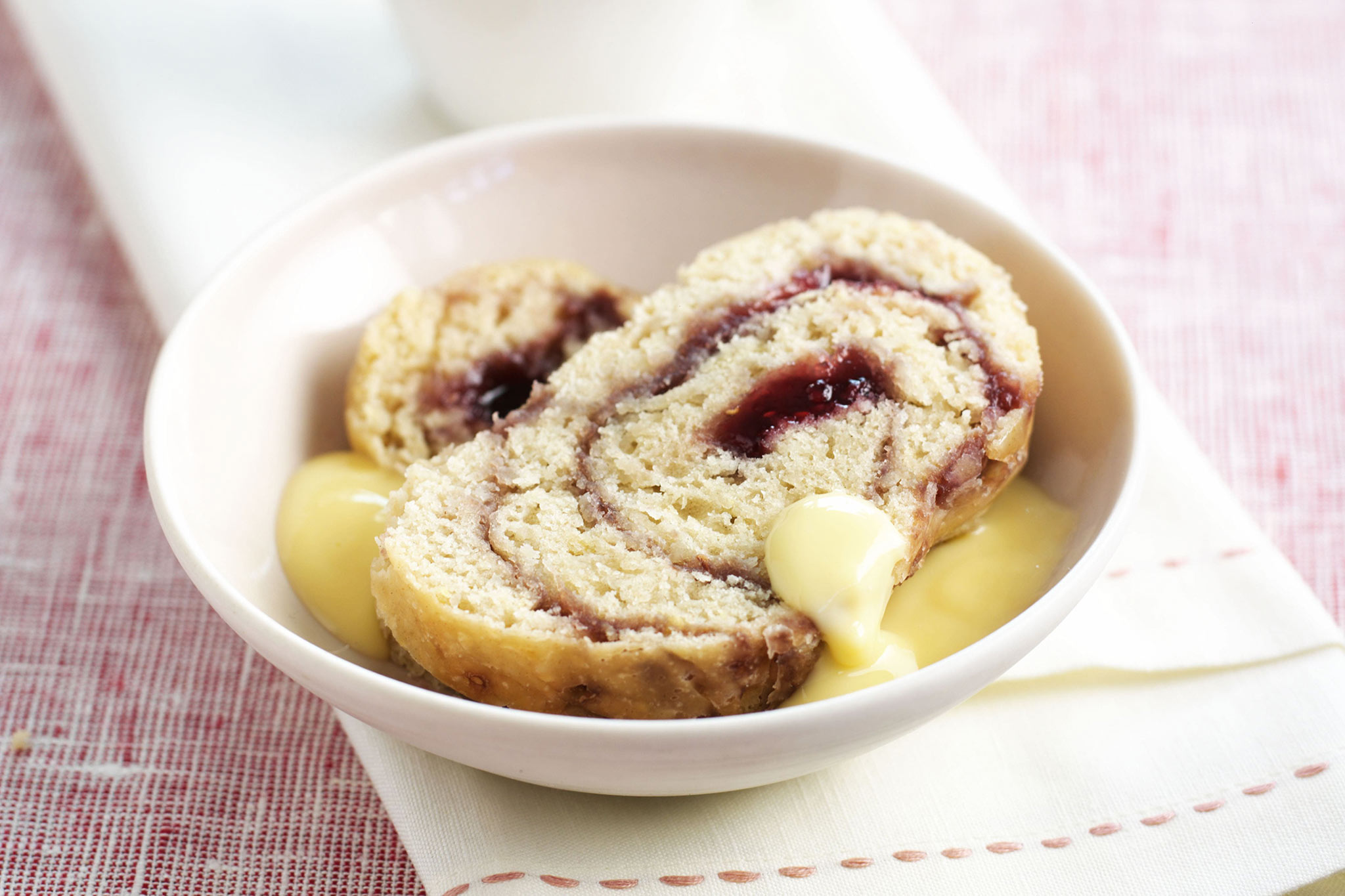From frozen fish fingers to vegan cuisine: Food trends through the decades
Food historian Polly Russell charts the amazing evolution of food in Britain over the past 60 years.
It appears we’ve come full circle – nostalgic foods and kitchen classics like quiches and fondues are popular once again, so how have the tastes of Britain changed and developed over the decades?
Here, Polly Russell, food historian and curator at the British Library, explains all…
1950s

The jam roly-poly was the pudding to serve
Although the Second World War ended in 1945, food rationing dragged on until 1954, so people’s diets were, for much of the decade, affected by the limited availability of ingredients and the relatively high cost of food. As the decade progressed, however, full employment and increased disposable incomes saw tastes start to change and new foods become available. This was the decade when frozen fish fingers and peas became household staples, teabags started to replace loose leaf, and instant coffee became available. Compared to today, most food was cooked from scratch, was relatively plain and often lacked variety. That said, popular Fifties dishes like Coronation Chicken – invented to celebrate the Queen’s coronation in 1953 – jam roly-poly and gooseberry fool are a reminder that even in less abundant times people could eat very well indeed.
1960s

The Sixties saw spaghetti bolognese enter UK kitchens
Incredibly, in 1961, just one in five British households owned a fridge (though more than 50% had a television), which meant food shopping for most households was an almost daily activity, and supermarkets were still few and far between. Tastes remained generally conservative, but there was change on the horizon: Italian cafés and trattorias became popular with the young and introduced a generation to garlic, olive oil and the very exotic spaghetti Bolognese for the first time. Across the country, Chinese immigrants set up restaurants and takeaways with hybrid menus serving chop suey, sweet and sour and chow mein, alongside chicken and chips, bread and butter and omelette. On TV, Fanny and Johnnie Cradock taught the nation how to impress guests with restaurant style food at home, and by the end of the decade, when 50% of the population finally had a fridge, aspic, a clear, savoury jelly used to make vegetable, fish and meat terrines, was seen as the height of sophistication.
1970s

Heinz Salad Cream – the summer staple
If the Sixties was the decade of the fridge, the Seventies was all about the freezer – and by the end of the decade, 50% of UK households had one. Freezer centres sprung up around the country and frozen convenience food like ‘boil in the bag’ fish, chips, cheesecake and crispy pancakes became popular. Alongside this increase in convenience food, many were embracing vegetarianism, health food and macrobiotic eating for the first time – this was the decade when pulses became an essential. In 1976, Britain experienced the hottest and longest summer on record, so it’s no wonder perhaps that ice cream and salad cream sales peaked in this period. The classic English salad, with beetroot, spring onions, half a tomato, lettuce leaves and boiled egg served with Heinz Salad Cream, was something my generation grew up with and the taste of a hot Seventies summer.
1980s

Strawberries became available year-round, not just during summer
By the Eighties, shopping at supermarkets was the norm. The chilled ready-meal market, which first hit supermarket shelves at the end of the 1970s, took hold thanks, in part, to microwave ownership, increased disposable incomes, and longer working hours for both men and women. At the same time as convenience food reduced the need to cook, food started to emerge as the nation’s number one leisure activity and cultural preoccupation. Magazines, books and TV shows dedicated to food and cooking appeared, cheap foreign travel expanded people’s culinary horizons and supermarkets, desperate for market share, offered new and exotic ingredients. Food-focused consumers lapped up sun-dried tomatoes, pesto, fresh coriander and year-round strawberries, while on the high street, Indian restaurants established themselves as a British tradition.
1990s

Pasta perfect
The Nineties is arguably the decade when food became a national obsession. There were more celebrity chefs than hot dinners, cookery book publishing exploded, supermarkets sourced foods from around the globe, farmers’ markets took off and eating out became a national pastime. One fad, encouraged by the success of the River Café cookery books, the popularity of Italian food and new chef on the block Jamie Oliver, was the pasta machine. For most, the fad didn’t last long, particularly once supermarkets cottoned on and started selling ranges of fresh pasta and sauces themselves. The now ubiquitous salad bags, with different leaf varieties, became widely available during the Nineties and rocket became a staple. Beyond Europe, tastes turned to Thailand with lemon grass, coconut milk and ginger, and Indian restaurant staple chicken tikka masala was dubbed ‘the national dish’ by the then Foreign Secretary Robin Cook.
2000s

The advent of artisan bread
In the 2000s, the term ‘food porn’ was coined, and celebrity chefs were branching out to campaign for healthier school dinners, animal welfare and food-waste reduction. The prepacked sandwich market, first established in the 1980s, was shaken up by the launch of prepack sushi, and Heston Blumenthal’s Fat Duck restaurant introduced the country to ‘modernist cuisine’ and the triple-cooked chip. While the convenience food industry continued to grow, a counter movement for ‘clean eating’ emerged and a quiet resurgence of artisan bread and British farmhouse cheese took hold in some quarters. As well as looking abroad for inspiration for new tastes and techniques, the 2000s were also marked by a growing interest and appreciation of British food traditions and native ingredients, as well as a tongue-in-cheek appreciation of classic dishes and condiments like prawn cocktail, steak Dianne, fish fingers and Heinz Salad Cream, with their nostalgic associations.
2010s

The rise of vegan and veggie food
So far, food trends in the 2010s have been dominated by concern about public health and the environment, and a related flourishing of vegetarian and vegan food. Our curiosity about world cuisines continues, with people exploring the foods of Korea, Nigeria and Ghana via street food markets and pop-ups. This looks set to be a decade when the way we shop changes too – delivery services are expanding and not just from supermarkets but for restaurants, fresh ready-to-cook meal solutions and farm schemes. While we’re more experimental and open to new tastes than ever before, we’re also drawn to comforting foods which remind us of the past and connect with our personal, social and cultural memories, hence the ongoing trend for nostalgic foods we’re currently seeing.
The Press Association
Latest posts by The Press Association (see all)
- What you need to know about weight loss jabs and how to make them work effectively - April 25, 2025
- Is our skin more susceptible to sun damage as we age? - April 25, 2025
- Special stamps to mark 80th anniversary of VE Day - April 24, 2025
- Test your knowledge with our penguin-themed quiz - April 24, 2025
- Prince Louis shows off missing front teeth in new photo to mark seventh birthday - April 23, 2025




















